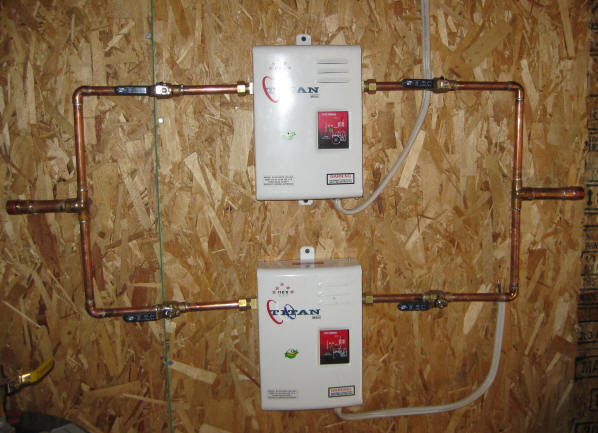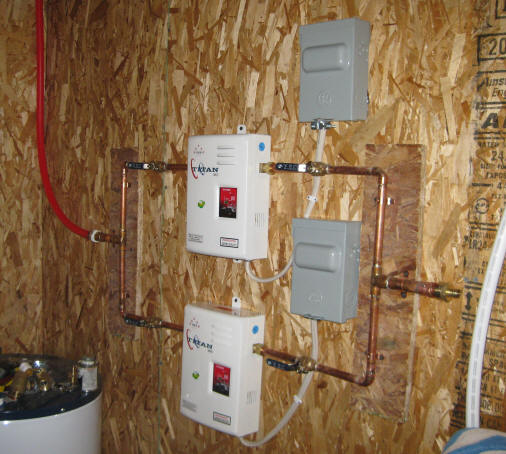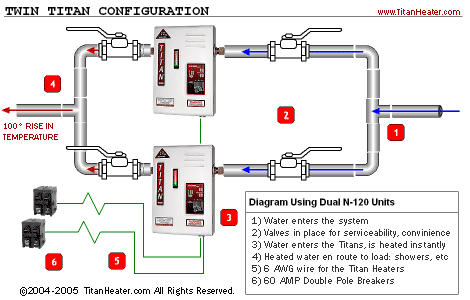Installing Tankless Water Heater
Also known as on-demand or instantaneous, on tankless water heaters only provide hot water as needed. Depending on your average daily usage, on demand water heaters can be 10-60% more efficient than standard tank water heaters because you have no standby losses associated with heat escaping from the tank. In the case of a cabin where you might go a week or two between actually using the hot water, savings with on demand will be even greater.
Electric tankless water heaters often provide hot water at a rate of 2-5 gallons per minute. Gas fired on demand water heaters can generate higher flow rates (6.5 to 9.5gpm are common). In our case, natural gas was not available so we chose to go with an electric tankless. Retrofitting an electric on demand water heater into an existing home is often difficult due to the extreme current requirements of these devices. You are looking at 100-150A at 220V to supply an entire house whereas a tank water heater is closer to 30A. The webpage below will guide you through the steps of installing a tankless water heater and show you how we installed an electric tankless water heater in our cabin.
After doing some research and looking for the best bang for the buck I came across the Titan SCR-2 N-120 Electric Tankless water heater. I picked up two on Amazon.com for $230 each and connected them in parallel as shown in the picture below. Another option for an entire house might be a single Tempra 36 or Tempra 29 made by Stiebel-Eltron. These models run $800+ so they are more expensive in the end. Using the dual heater approach, if one were to go out, you'd at least be able to get by on the other one while you get it fixed.
Once you've picked out the electric tankless water heater you want to install you need to look at the power requirements for the device. One of the more difficult steps to installing a tankless water heater is getting the electric power to the device or in the case of a gas tankless unit, running gas and exhaust vents.

The Titan SCR-2 comes with an electric wire stub that is about 18" long as shown above. Some people will wire this into a 220V electrical plug and then have a 220V receptacle on the wall to plug into. When I saw the price of 220V plugs and receptacles at Lowes I choose a different route. As shown below I just tied each one to a 60A disconnect switch which cost $12 each. The copper connections to the tankless are 1/2" compression fittings so no soldering is required to the actual unit. We soldered in isolation valves as recommended by the manufacturer. Also, you might be wondering why we messed with soldering versus just using PEX to the water heater. The manufacturer actually recommends 36" of copper pipe between the unit and and PEX or plastic pipe to prevent heat damage to the pipe.

Titan recommends going with the parallel configuration if you need more temp rise rather than trying a series configuration. Plumbing two tankless units in series will give you twice the flow restriction. I've included a chart below showing expected water flow. Just to mention again, these things draw some serious power. Each is on a 60A breaker and each requires a 6/2 copper line from your breaker panel.
That's about it. You can see it really isn't too complicated to install your own tankless water heater. Gas tankless setups are a little more involved and similar to the electric, you need to insure you have the proper size utility feeding your device..in this case a large enough gas line. Even though these devices are small, they require a lot of energy.
For more information on installing the twin tankless setup see http://www.titanheater.com/tankless_water_heater_northern.php
I've also included their diagram below for quick reference.

For a single Titan N-120 you will get the temperature rise shown below. A single tankless water heater might work for a small home or where ground water is above 70F. In colder climate, you will need a higher wattage unit or a dual setup. For a dual setup you can double the temp rise numbers shown below which will easily cover a couple appliances simultaneously.
| Temperature Rise Chart (° Fahrenheit) above your ambient temperature | ||||||||||||||||
|
Notes: GPM - Gallons per minute. Degrees (°) Fahrenheit. Values are approximate.
Another thing to mention is the Titan N-120 requires a minimum of 0.4 GPM to activate. This doubles to 0.8 GPM when you go in parallel so you need to keep that in mind if you have an application for hot water that has a very low flow rate. Other single tankless whole-house water heaters such as the Tempra 36 or 29 require 0.87 GPM so there is no benefit going that route as far as min flow rates go.
Tankless Water Heater - How many gpm do you need?
Tankless water heaters will usually specify how many gallons-per-minute (gpm) of hot water they will produce. The gpm rating on the appliance it typically for the lowest rise in water temperature...in other words, it assumes the water is already warm to get that many gallons-per-minute of hot water. Here are the specifications for an 8.4 gpm Rheem natural gas tankless water heater from Home Depot:
Flow Rate @ 35°F Rise (gallons/min) : 8.4 gal
(US)/min
Flow Rate @ 45°F Rise (gallons/min) : 6.6 gal
(US)/min
Flow Rate @ 77°F Rise (gallons/min) : 4.0 gal
(US)/min
To get 8.4 gpm of 115 degree water, the water temperature entering the unit would have to be 80 degrees...in reality your incoming water temperature will be 55-75F depending on where you live. If you live in a cold northern climate, you may in fact only be able to produce 4-5 gpm of hot water out of this unit in the winter.
Once you understand tankless water heater specifications it's time to do some quick numbers to determine how many gpm will be required to support your home or apartment. The follow chart list the average flow rates for some typical appliances and water fixtures in your house. Newer facets and show heads are typically more water conscious (low-flow) and will be around 1.5-2.5 gpm versus older fixtures that might be 3+ gpm. You can always change out shower heads on older homes to reduce your water consumption and reduce the demand on your water heater.
| Typical Flow Rates in Gallons per Minute (gpm) | |||||||
| Fixture Type | Lavatory | Bathtub | Shower | Kitchen Sink | Pastry Sink | Laundry Sink | Dishwasher |
| Flow Rates | 0.5 | 2.0 – 4.0 | 1.5 – 3.0 | 1.0 – 1.5 | 1.5 – 2.5 | 2.5 – 3.0 | 1.0 – 3.0 |
To determine the total flow you will need from your tankless heater, add up the flow rates of each fixture and appliance you want to be able to run simultaneously. Let's say for example you have 2 showers (each 2 gpm) that may run at the same time each morning, along with a dishwasher or a clothes washer (2 gpm). That would add up to be 6 gpm that you would need to be able to heat water for at the same time. In this example, the 8.4 gpm model above would work just fine.
What is a Safe Temperature for a Hot Water Heater?
One can practice both safety and economy by keeping water temperature at doctor approved levels. Very hot water temperature can cause burns extremely fast, and as such, care in setting your hot water heater is required. Setting the hot water temperature lower also means a savings in energy bills for heating the home's water - if you are using a standard tank water heater. Tankless setups will see minimal energy saving. One downside however is a lower temperature does mean you will run out of hot water more quickly with a standard tank water heater. The tankless setup of course never runs out of hot water:)
Most experts recommend that hot water temperature should not exceed 125° F (51.66° C). A water temperature exceeding this poses serious risk of bad burns, particularly to children. In fact even at 125° F, if the child puts his or her hand in the water continuously for two minutes he or she may get second or third degree burns.
Some pediatricians instead suggest setting the hot water temperature at 120° F (48.88° C). With this water temperature, a child would have to run water over the same place for ten minutes prior to receiving a severe burn.
Temperatures higher than 125° F can burn a child, or an adult quite severely, and quite quickly. For example, it is estimated that it takes only two seconds of exposure to water at 150° F (65.55° C) and only six seconds of exposure to water at 140° F (60° C) to cause a very bad burn to a child.
Some are concerned that lowering the water temperature will result in soap working improperly in dishwashers or washing machines. Actually most soap and detergent is meant to work at between 120° to 125° F. Thus soap is actually designed for this temperature.
Others are concerned that lowering water temperature might lead to greater chances of passing illness between family members. Actually, the best method for preventing illnesses is handwashing with warm, not hot, soapy water. 120° F water is quite hot enough to wash most germs away. It will not always work, since some germs are airborne and one contracts them through exposure or inhalation of the infected droplets of someone else, as after a sneeze.
In terms of cost saving, dropping the water temperature setting by ten degrees typically saves approximately 4% on one’s cost to heat water each year. This can make a profound difference if dropping the water temperature from 150° to 120° F, saving essentially 12% a year. Again, these savings are based on a standard tank water heater, not tankless.
Back to top - Tankless Water Heaters
